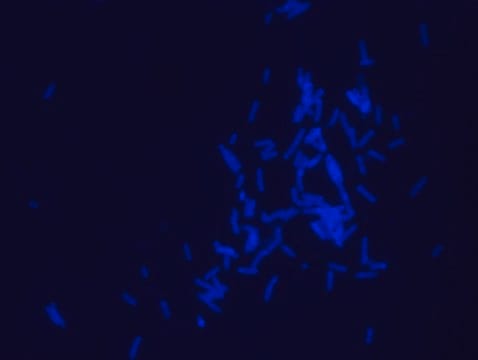おすすめの製品
由来生物
Streptomyces hagronensis
品質水準
アッセイ
≥98% (HPLC)
形状
powder
色
white
溶解性
DMSO: 1 mg/mL
抗生物質活性スペクトル
Gram-negative bacteria
作用機序
enzyme | inhibits
保管温度
−20°C
−20°C
InChI
1S/C32H57N5O9/c1-9-11-12-13-14-24-20(6)32(45)37(8)23(15-18(3)4)29(42)35-26(19(5)10-2)31(44)34-22(17-38)28(41)36-27(21(7)39)30(43)33-16-25(40)46-24/h18-24,26-27,38-39H,9-17H2,1-8H3,(H,33,43)(H,34,44)(H,35,42)(H,36,41)
InChI Key
VFGBXFZXJAWPOE-UHFFFAOYSA-N
関連するカテゴリー
詳細
グロボマイシンは環状ペプチド抗生物質であり、腸内グラム陰性バクテリアの細胞壁合成を阻害することによって、このバクテリアの増殖を抑止します。
アプリケーション
- Globomycin, a new peptide antibiotic with spheroplast-forming activity. I. Taxonomy of producing organisms and fermentation.: This study explores the taxonomy of the producing organisms of Globomycin and details the fermentation processes involved. This antibiotic shows spheroplast-forming activity, indicating its potential application in targeting bacterial cell wall synthesis (Inukai et al., 1978).
生物化学的/生理学的作用
グロボマイシンはLspA(リポ蛋白信号伝達ペプチド)阻害効果を持つことが知られています。 この物質はプロリポ蛋白をリポ蛋白へ変換する酵素を阻害することによってプロリポ蛋白の変異を根絶し、グラム陰性バクテリアの外側の膜におけるシグナル配列の基質類自体として機能します。
保管分類コード
11 - Combustible Solids
WGK
WGK 3
引火点(°F)
Not applicable
引火点(℃)
Not applicable
適用法令
試験研究用途を考慮した関連法令を主に挙げております。化学物質以外については、一部の情報のみ提供しています。 製品を安全かつ合法的に使用することは、使用者の義務です。最新情報により修正される場合があります。WEBの反映には時間を要することがあるため、適宜SDSをご参照ください。
Jan Code
G1424-BULK:
G1424-VAR:
G1424-1MG-PW:
G1424-1MG:
試験成績書(COA)
製品のロット番号・バッチ番号を入力して、試験成績書(COA) を検索できます。ロット番号・バッチ番号は、製品ラベルに「Lot」または「Batch」に続いて記載されています。
Isabelle Leduc et al.
Infection and immunity, 72(6), 3418-3428 (2004-05-25)
Haemophilus ducreyi, the causative agent of chancroid, is highly resistant to the complement-mediated bactericidal activity of normal human serum (NHS). Previously, we identified DsrA (for ducreyi serum resistance A), a major factor required for expression of the serum resistance phenotype
Suneeta Khandavilli et al.
Molecular microbiology, 67(3), 541-557 (2007-12-19)
Cell surface lipoproteins are important for the full virulence of several bacterial pathogens, including Streptococcus pneumoniae. Processing of prolipoproteins seems to be conserved among different bacterial species, and requires type II signal peptidase (Lsp) mediated cleavage of the N-terminal signal
Francisco Sarabia et al.
The Journal of organic chemistry, 76(7), 2132-2144 (2011-03-04)
The syntheses of the natural lipocyclodepsipeptide-type antibiotics globomycin and SF-1902 A(5) are reported, utilizing solid phase technology for the construction of the peptidic fragment and a new asymmetric methodology of epoxidation for the preparation of the lipidic chain. The linkage
D A Haake et al.
Infection and immunity, 66(4), 1579-1587 (1998-04-07)
We report the cloning of the gene encoding a 36-kDa leptospiral outer membrane lipoprotein, designated LipL36. We obtained the N-terminal amino acid sequence of a staphylococcal V8 proteolytic-digest fragment in order to design an oligonucleotide probe. A Lambda-Zap II library
Mikio Shoji et al.
Molecular microbiology, 52(5), 1513-1525 (2004-05-29)
Bacterial cell surface filaments play significant roles in adherence to and invasion of host cells. They are generated by the chaperone/usher pathway system (class I fimbriae), the type II secretion system (type IV pili) and the nucleation-dependent polymerization system (Curli
ライフサイエンス、有機合成、材料科学、クロマトグラフィー、分析など、あらゆる分野の研究に経験のあるメンバーがおります。.
製品に関するお問い合わせはこちら(テクニカルサービス)






